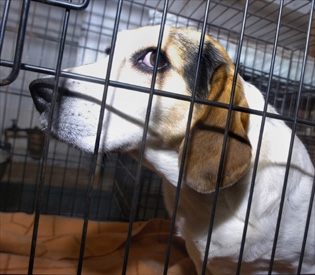 It appears dog flu is raising its ugly head again, this time in New Jersey. According to the Star Ledger, the virus has been found in Burlington, Mercer, and Sussex Counties. There is no cure, and as many as 80% of exposed dogs will get the disease.
It appears dog flu is raising its ugly head again, this time in New Jersey. According to the Star Ledger, the virus has been found in Burlington, Mercer, and Sussex Counties. There is no cure, and as many as 80% of exposed dogs will get the disease.
Yearly Archives: 2008
Dog Bite Prevention Program
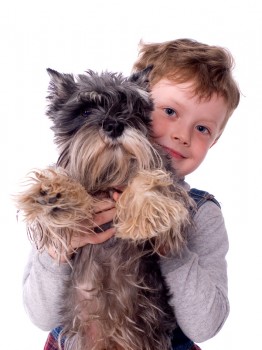 At its annual convention in New Orleans this month, the American Veterinary Medical Association announced a new program aimed at reducing dog bites among children aged 3 – 6. Children younger than three should never be left alone with any dog, the group is quick to point out.
At its annual convention in New Orleans this month, the American Veterinary Medical Association announced a new program aimed at reducing dog bites among children aged 3 – 6. Children younger than three should never be left alone with any dog, the group is quick to point out.
According to Dr. Ilana Reisner of the University of Pennsylvania, dog bites happen when people don’t understand dog behavior. “Children are more likely to get bitten by dogs because of the way they interact with dogs.” Continue reading Dog Bite Prevention Program
Should Dogs Be Allowed at Work?
Kayla’s Dog DNA Update
 Loyal readers will remember I sent away Kayla’s DNA to see what she is made of on June 29th. I received an e-mail last week stating that my order had been received and was in process. Before the results are in, any guesses? She has the coat of a German Shepherd, but a curled tail like a Huskie or Chow. She’s just a bit bigger than my Golden Retriever. Also, she is on the aggressive side. We saw her mom, who I thought looked a lot like a Border Collie. From her picture above, what would you say?
Loyal readers will remember I sent away Kayla’s DNA to see what she is made of on June 29th. I received an e-mail last week stating that my order had been received and was in process. Before the results are in, any guesses? She has the coat of a German Shepherd, but a curled tail like a Huskie or Chow. She’s just a bit bigger than my Golden Retriever. Also, she is on the aggressive side. We saw her mom, who I thought looked a lot like a Border Collie. From her picture above, what would you say?
Saving Pets from Smoke Inhalation
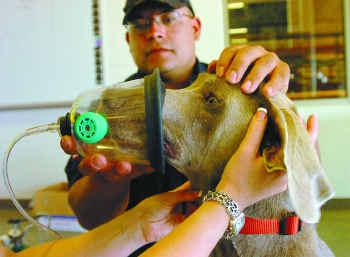 From the Dallas Morning News: What a great idea! As many as 40,000 pets are killed in fires each year, usually from smoke inhalation. The number is so high because pets, scared by the fire, smoke, and commotion, often hide from firefighters.
From the Dallas Morning News: What a great idea! As many as 40,000 pets are killed in fires each year, usually from smoke inhalation. The number is so high because pets, scared by the fire, smoke, and commotion, often hide from firefighters.
To help combat this problem, firefighters in McKinney, Texas now have access to special equipment that will fit over a dog or cat’s muzzle to administer oxygen. These kits, given to the fire department by Dog Scouts of America, Troup 119, cost about $55 each.
Keri Price Grant, fire and life safety coordinator with the McKinney Fire Department, says, “For years we just tried to use human oxygen masks. We tried to retrofit the mask to fit a dog, and that doesn’t work well. We are not a mobile veterinary care unit, and these kits are strictly for use in a fire. Our top priority is saving human beings, but in our society, many people consider their pets to be their children and members of their family.”
The kits come with three sizes of muzzle masks to fit most household pets. The Dog Scout Troop has donated 85 kits to fire departments all over the Dallas area, with a promise to resupply the disposable masks as needed.
Dog Scouts of America is a non-profit group which seeks to encourage responsible pet ownership. Two paws up to them for such a thoughtful gift!
Until next time,
Good day, and good dog!
Picture Credit:
MWD: Meapons of Wass Destruction?
No, actually MWD stands for military working dog. The US Air Force has recently shed a bit of light on the training program it uses to train dogs for everything from guard duty to explosives detection.
First, the dog must be the right breed. The Air Force most commonly uses German Shepherd and Belgian Malinois, with a slight preference for the Malinois due to its longer average lifespan. Next, the dog is evaluated for its drive or “ability to remain focused and determined to obtain a goal”, according to Staff Sgt. Manuel Garcia of the 35th Security Forces Squadron.
The dog must undergo basic training, just as airmen do, at Lackland Air Force Base in Texas. The program lasts from four to six months, depending on whether or not the dog gets held back for remedial training.
After being sent to its permanent base, the dog spends a few weeks with its new handler, learning to follow his commands. When the dog is ready, they review the basic obedience learned at Lackland, staying close to the handler and obeying his basic commands.
A few weeks later, the dog moves on to advanced obedience, where he learns to follow the same commands, even though he is off leash and at a distance from his handler. The dog also learns to crawl and roll, tactical moves he may need later.
Soon, the lessons begin to include actual work skills such as detection, attack, search, and working under the gun (literally!)
Once trained, the dog will work between 10 and 12 years, then be retired. He could be adopted, returned to Lackland to train new dogs, or be given to local police departments for further work.
A round of applause for our military working dogs! (As well as those they work with!)
Until next time,
Good day, and good dog!
Morris Animal Foundation
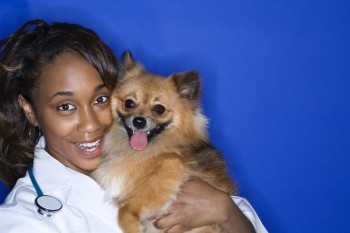 The Morris Animal Foundation has been in business for 60 years, dedicated to finding animal health research. When I first read about the Foundation, I was surprised that they were worried about dogs, because I thought it was named for the cat food commercial Morris. Shows you what I know! The Foundation was established by a veterinarian named Dr. Morris, who wanted to improve the health condition of all animals.
The Morris Animal Foundation has been in business for 60 years, dedicated to finding animal health research. When I first read about the Foundation, I was surprised that they were worried about dogs, because I thought it was named for the cat food commercial Morris. Shows you what I know! The Foundation was established by a veterinarian named Dr. Morris, who wanted to improve the health condition of all animals.
Noting that cancer is the number one cause of death in dogs over the age of two, the Foundation has posted an exclusive presentation (as above + /ccexclusive) on its website featuring information and insight from leading canine cancer research centers. There is a question and answer section, facts about canine cancer, and updates on cancer research from Cornell University’s College of Veterinary Medicine. The site also has links to leading vet centers in the US and UK.
The Foundation has launched a global campaign to raise funds to cure canine cancer in the next 10 – 20 years, while providing more effective treatments in the meantime. You can learn more about the fundraising efforts here. And for those of you who are a bit suspicious of a charity you have never heard of, Charity Navigator ranks the Morris Animal Foundation as a four-star charity, the highest available rating.
Until next time,
Good day, and good dog!
Sounds Like An Even Trade…
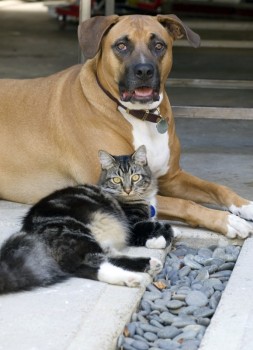 From Greenacres, FL: When Linda Urioste’s Labrador was picked up by animal control officers, she thought she had lost the dog forever. After a few days, the dog was adopted by another couple. Upon learning that Ms. Urioste was looking for the dog, the couple thought about giving him back, until Ms. Urioste yelled at them and threatened to sue.
From Greenacres, FL: When Linda Urioste’s Labrador was picked up by animal control officers, she thought she had lost the dog forever. After a few days, the dog was adopted by another couple. Upon learning that Ms. Urioste was looking for the dog, the couple thought about giving him back, until Ms. Urioste yelled at them and threatened to sue.
After awhile, the couple who had the dog realized that their cat was missing. Ms. Urioste called and left them a message that they would only get their cat back when she got her dog back.
Needless to say, now Ms. Urioste is in the pokey, charged with theft and extortion. No word yet as to who has the animals
Until next time,
Good day, and good dog!
Boating with Bonzo
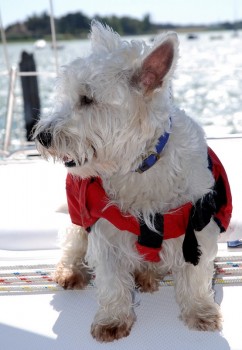 Riding in the bow of the boat, wind whipping up all kinds of good smells, hair blowing in the breeze…no wonder dogs like to go out boating with you! Here are a few safety tips to keep in mind.
Riding in the bow of the boat, wind whipping up all kinds of good smells, hair blowing in the breeze…no wonder dogs like to go out boating with you! Here are a few safety tips to keep in mind.
1. Regardless of whether or not you bring the dog, DON’T DRINK AND DRIVE. It’s just as dangerous in a boat as it is in a car, and your dog needs you to come home tonight.
2. Keep an eye on your dog, especially while the boat is moving. If he falls overboard, he had a good chance of getting nipped by the propeller.
3. Try a short trip first, to see if your dog enjoys it. If he’s scared, plan to leave him home next time.
4. Use a personal flotation device, even if your dog is a good swimmer. He may not know his limitations and may become tired before he makes it back to the boat. Try to find a PFD that has a handle on the back, allowing you to lift the dog out of the water.
5. Provide shade so the dog does not get overheated. If you have a hairless dog, use sunscreen.
6. Provide stable footing for the dog by laying a piece of carpet or a rubber mat over a fiberglass deck.
7. Make sure your dog has a legible ID tag and / or a microchip, in case you get separated from him.
Enjoy the lake!
Until next time,
Good day, and good dog!
Another problem with global warming…
 As the earth warms up, it appears more slugs and snails are migrating to Scotland. Which wouldn’t be so bad, except that they carry an tapeworm known as “French heartworm”. This parasite has never before been seen in Scotland, but was confirmed by the vet finding larvae in the feces of a Weimeraner.
As the earth warms up, it appears more slugs and snails are migrating to Scotland. Which wouldn’t be so bad, except that they carry an tapeworm known as “French heartworm”. This parasite has never before been seen in Scotland, but was confirmed by the vet finding larvae in the feces of a Weimeraner.
The dog had never left the city of Glasgow, so they are sure he contracted the disease there. Vets speculate that he may have eaten a slug or eaten grass that had a slug trail on it. (Yuck!!)
So far, there are no reports of this organism infecting dogs in North America, but symptoms include coughing, breathing difficulty, and unexplained bleeding.
Until next time,
Good day, and good dog!

